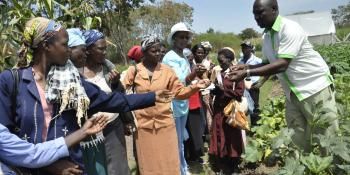The World Bank scales up insights from Climate-Smart Villages in Niger

Summary
Niger’s population is highly dependent on agriculture, but faces constant risks aggravated by climate change. The CGIAR Research Program on Climate Change, Agriculture and Food Security (CCAFS) West Africa Program set up the climate-smart village (CSV) Kampa Zarma in Niger to test climate-smart agriculture (CSA) interventions. To engage the local community, these interventions were designed through a participatory diagnosis. CCAFS and World Agroforestry Centre (ICRAF) have documented the implications and successes of various CSA practices. These experiences were used by The World Bank to inform the design of its 7-year USD 111 million CSA project in Niger, aligned with the large government initiative ‘Nigeriens Nourish Nigeriens’.
Background
Niger is one of the most food insecure countries of the world, with two-thirds of its surface covered by desert and no border at the sea. Agricultural production is the principal source of livelihood for over 80% of Nigeriens, according to the World Bank, but it faces constant risks of droughts, floods, pests and diseases. These risks are exacerbated by climate change, so it is of vital importance for Niger’s population to increase the resilience and productivity of its agriculture.
In this context, CCAFS set up the CSV Kampa Zarma in Niger to test CSA interventions. These interventions were designed by the local community through a participatory diagnosis. In this manner, CCAFS, ICRAF and other partners could document since 2012 how different practices, technologies and institutional arrangements contributed to the pillars of CSA. In 2015, the World Bank requested the support of CCAFS to design its CSA project in Niger, and representatives of the World Bank and the Nigerien government visited Kampa Zarma village. During the field visit, participants and the inhabitants from Kampa Zampa discussed various CSA options, such as assisted natural tree regeneration, the ‘zaï’ technique to increase soil fertility and the use of improved millet varieties.
Consequently, the World Bank used the knowledge generated by CCAFS’ research in Kampa Zarma to inform the design of its 7-year USD 111 million CSA project in Niger. This project is the first project of the World Bank in Africa designed specifically to deliver CSA and has been aligned with the large government initiative ‘Nigeriens Nourish Nigeriens’. The objective is to increase agricultural productivity and enhance drought resilience of agro-pastoral systems in 60 communities around the country. In this manner, 500 000 farmers and agro-pastoralists will become more food secure.
Key facts
- CCAFS and partners have documented the implications and successes of various CSA interventions since 2012 in CSV Kampa Zarma.
- In 2015, the World Bank requested the support of CCAFS to design its CSA project in Niger.
- Representatives of the World Bank and Nigerien government visited the CSV Kampa Zarma to see and discuss CSA options.
- The World Bank used the insights from the CSV Kampa Zarma to inform the design of its 7-year USD 111 million CSA project in Niger.
Lessons: Key elements of success
- Designing agricultural interventions in a participatory diagnosis helps to engage the local community.
- Experiences from model CSVs serve to design CSA projects on a large scale.
Further reading
- Blog: A real opportunity to scale up Climate-Smart Villages in Niger
- 2016 Annual Report story: CCAFS research helps shape US$350M investment in climate-smart agriculture in Niger and Kenya
- Guardian article: Niger seeks funds for Nigeriens Nourish Nigeriens agriculture initiative on Nigeriens Nourish Nigeriens agriculture initiative
- World Bank appraisal document: CSA support project in Niger
Related research outputs
- Occasional paper: Towards developing scalable climate-smart village models: approach and lessons learnt from pilot research in West Africa
- Journal article: Markets and climate are driving rapid change in farming practices in Savannah West Africa
- Book: West African agriculture and climate change: a comprehensive analysis



